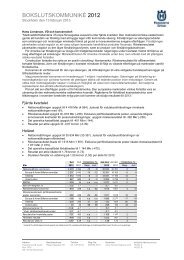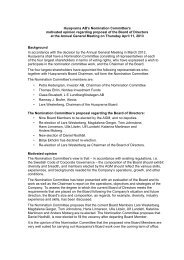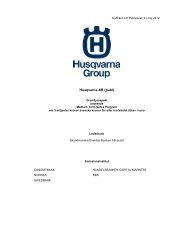Annual Report 2009 - Husqvarna Group
Annual Report 2009 - Husqvarna Group
Annual Report 2009 - Husqvarna Group
Create successful ePaper yourself
Turn your PDF publications into a flip-book with our unique Google optimized e-Paper software.
78 <strong>Husqvarna</strong> <strong>Annual</strong> <strong>Report</strong> <strong>2009</strong> Notes<br />
Amounts in SEKm unless otherwise stated.<br />
Cont. Note 19<br />
Historical information <strong>2009</strong> 2008 2007 2006<br />
Present value of defined<br />
benefit obligations 2,964 2,855 2,590 1,746<br />
Fair value of plan assets 1,540 1,383 1,447 1,342<br />
Funded status 1,424 1,472 1,143 404<br />
Experience adjustment on<br />
plan liabilities –14 32 35 –3<br />
Experience adjustment<br />
on plan assets 68 –183 –21 –26<br />
Principal actuarial assumptions at the balance sheet<br />
date (expressed as a weighted average)<br />
% 31 Dec <strong>2009</strong> 31 Dec 2008<br />
Discount rate<br />
Europe 5.1 5.1<br />
North America 5.8 6.1<br />
Rest of the World 2.0 1.4<br />
Expected long-term return<br />
on assets<br />
Europe 5.6 5.7<br />
North America 5.7 6.0<br />
Rest of the World 2.5 2.5<br />
Expected salary increases<br />
Europe 3.4 3.1<br />
North America 4.5 4.0<br />
Rest of the World N/A 3.5<br />
In determining the discount rate, AA-rated corporate bonds<br />
indexes matching the duration of the pension obligations are<br />
applied. If no suitable corporate bonds are available government<br />
bonds are used to determine the discount rate. To<br />
determine the expected return, return on equity and equity<br />
related instruments the historical risk premium for equities<br />
and current bond yields are applied. The return on fixed<br />
income and fixed income related investments is based on current<br />
bond yields. The weighting of asset classes is determined<br />
by using the respective scheme’s benchmark asset allocation,<br />
which for all major schemes is set out in the <strong>Group</strong>’s financial<br />
policy. An increase or decrease of one percentage point in<br />
the assumed medical cost trend rate would have no material<br />
impact on the <strong>Group</strong>’s current service cost or post-employment<br />
benefit obligations.<br />
The company expects to make contributions of approximately<br />
SEK 104m to the plans during 2010.<br />
Reconciliation of changes in net provisions for<br />
pensions and other post-employment benefits<br />
Pensions,<br />
defined<br />
benefit plans<br />
Other postemployment<br />
benefits<br />
Total<br />
Net provisions for pensions<br />
and other postemployment<br />
benefits,<br />
31 Dec 2008 1,007 27 1,034<br />
Acquisitions 0 0 0<br />
Pension expenses 154 2 156<br />
Employer contributions<br />
and benefits paid directly<br />
by the Company –139 –5 –144<br />
Reclassification 14 — 14<br />
Exchange rate<br />
differences –60 –1 –61<br />
Net provision for pensions<br />
and other postemployment<br />
benefits,<br />
31 Dec <strong>2009</strong> 976 23 999<br />
Parent Company<br />
According to Swedish accounting principles adopted by the<br />
Parent Company, defined benefit liabilities are calculated on<br />
the basis of officially provided assumptions, differing from the<br />
assumptions used in the <strong>Group</strong> under IFRS. The pension benefits<br />
are secured by insurance policies, contributions to a separate<br />
fund or are recorded as a liability in the balance sheet.<br />
The accounting principles used in the Parent Com pany’s separate<br />
financial statements differ from the IAS/IFRS principles,<br />
primarily as regards the following areas:<br />
• The pension liability calculated according to the Swedish<br />
accounting principles does not take into account future<br />
salary increases.<br />
• The discount rate used in the Swedish calculations is established<br />
by the Swedish Financial Supervisory Authority.<br />
• Changes in the discount rate and other actuarial assumptions<br />
are recognized immediately in the income statement<br />
and the balance sheet.<br />
• Any deficit must be either immediately settled in cash or<br />
recognized as a liability in the balance sheet.<br />
• Any surplus cannot be recognized as an asset but may, in<br />
some cases, be refunded to the company to offset pension<br />
costs.

















